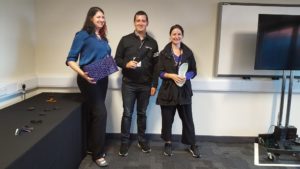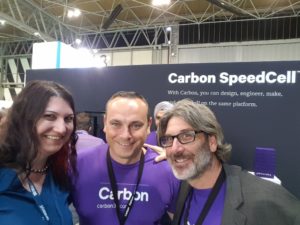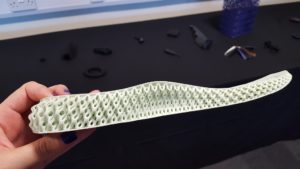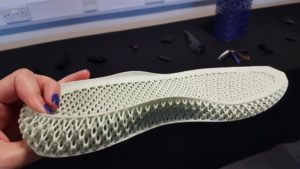 Carbon has been working to speed up the adoption of 3D printing — and not only through its high-speed 3D printing process, which emerged from stealth two years ago. CLIP technology allows for a fast, precise 3D print that is, the company is keen to note, adaptable for scale production. While the primary application for 3D printing has historically been and is likely to remain for some time in rapid prototyping, Carbon is among those ambitious young companies seeking to push beyond prototyping and into production. The biggest move so far for the smart company to put its money where its mouthpiece is comes in the way of a major partnership with shoe producer adidas, which is promising to create hundreds, then thousands, and eventually perhaps millions of pairs of commercially available shoes as 3D printing ramps up into mainstream production.
Carbon has been working to speed up the adoption of 3D printing — and not only through its high-speed 3D printing process, which emerged from stealth two years ago. CLIP technology allows for a fast, precise 3D print that is, the company is keen to note, adaptable for scale production. While the primary application for 3D printing has historically been and is likely to remain for some time in rapid prototyping, Carbon is among those ambitious young companies seeking to push beyond prototyping and into production. The biggest move so far for the smart company to put its money where its mouthpiece is comes in the way of a major partnership with shoe producer adidas, which is promising to create hundreds, then thousands, and eventually perhaps millions of pairs of commercially available shoes as 3D printing ramps up into mainstream production.
These are big claims, and it is to be expected that many take them with more than a grain of salt following the crash of expectations following a significantly overhyped few years in additive manufacturing. Carbon is ready to back up its promises, though, and the team were present at the recent TCT Show in the UK — wearing their Futurecraft 4D shoes as they have at shows since the announcement — and ready to talk. During the course of the show, I enjoyed the opportunity to sit down to chat with Co-Founder and VP of Business Development Phil DeSimone and VP of Marketing Valerie Buckingham; run into Head of Production Partnerships Dana McCallum and hear her speak on a materials panel; and catch up at the booth with newer-to-the-Carbon-team industry veterans Production Development Engineers Gary Miller and Jason Lopes.
- I enjoyed catching up with Phil and Valerie…
- …Gary and Jason…
- …and Dana at TCT Show 2017
“Up to this point, we have seen a lot of growth in materials,” DeSimone told me. “Now we are seeing more in people, and more happening across the pond.”
Scaling up operations outside its native California, Carbon has been expanding its team in the UK to bring the tech over the Atlantic to gain a stronger global foothold. At this UK-based tradeshow, the company announced its new bulk resin pricing scheme, which DeSimone described as the “next jump, the next piece of production 3D printing.”
“Machine, labor, and materials” are the foundational aspects of a successful manufacturing ecosystem, he explained. “SpeedCell addressed the first two, and now we are looking to the third. With the MMD, prices drop 40 times immediately, and will see this more as we go on. This is a big deal, in talking about production components, a very important piece.”
The SpeedCell system, introduced in March of this year, was created in response to customer feedback. Focusing now on the materials side of production 3D printing allows for a wider look at a scaled environment. During TCT Show, the team saw that “this show ticks the boxes in announcements,” as Buckingham put it.
“This is lending credence to what to now has been our claim about production; this system is a proof point of not just words,” she explained of the significance of bulk availability and pricing.
 Work with partners has been integral to Carbon’s expansion, a key underpinning to growth in the 3D printing industry. For the latest announcement, the company has noted installations in the UK and Germany as they begin building out their international supply chain, as well as a significant boost from partner Henkel in developing the MMD (mix, meter, dispense) system.
Work with partners has been integral to Carbon’s expansion, a key underpinning to growth in the 3D printing industry. For the latest announcement, the company has noted installations in the UK and Germany as they begin building out their international supply chain, as well as a significant boost from partner Henkel in developing the MMD (mix, meter, dispense) system.
“Henkel is stepping it up in additive manufacturing. They’re really gung-ho in getting into this industry,” DeSimone said.
“The key is they need to see applications, see things like this,” he continued, motioning to his Futurecraft 4D shoes. “Even if you add up all of prototyping, that’s still a drop in the bucket; production applications are key.”
He emphasized the critical nature of materials as an “important piece of the story,” as Carbon continues work to truly differentiate itself in the marketplace. Working with large-scale production partners across a variety of verticals, the well-publicized shoes will by no means be the only place we can expect to see their unique technologies taking on traditional manufacturing. Shoes will remain quite a focus, though, as footwear has a substantial amount of benefits in 3D printing; this market and partnership, DeSimone said, are integral to seeing adoption rise, as “we expect adidas to be the largest user of additive equipment in the world by the end of next year and we, at Carbon, are excited to help them get there.”
As Carbon continues to enter markets, they want to be very clear about what they’re doing — crystal clear.
“This continues the path of being transparent in pricing and technology,” DeSimone explained. “Our announcement has all the machine, accessory, and material pricing. We’re being completely transparent on all of these. Others show a cost comparison with injection molding versus 3D printing where 3D printing is a straight line and that’s baloney. There is a curve for additive, and we’re working to address that curve with a bulk approach.”
The ‘baloney’ nature of that straight line has finally started to become more noted in the business of 3D printing, and it’s certainly refreshing to hear directly from a big name in the industry that they’re well aware of the fact of a pricing curve.
Through keeping very clear about their objectives and approaches, Carbon is looking to create what Buckingham called a “fruitful ecosystem” wherein all players are able to best collaborate and drive innovation forward.
“Players need to understand how these all can come to life together,” she said of the moving pieces in the equation. “At the core, we need to be cooperating and working together. No single player is the pinch point to value, and we’re working to that with additive manufacturing. We’re working closely with partners, and will have more exciting news to share soon on that.”
As we Americans chatted in the UK, focus came to business across the pond, where partnerships and installations are bearing truth to last year’s announced vision of global expansion. With production partners including Citim and Oechsler in Germany, and Fast Radius and Paragon Rapid Technologies in the UK, the expansion and addition of new partners has been “really good for us,” DeSimone said as they look to growth in the European market. The company has its sights set on further expansion, and when I asked what that might mean for Asia, DeSimone noted that we might see Carbon’s technology in Japan “sooner than you think,” and touched on CEO Joseph DeSimone’s recent mention of installed machines at BMW Motorrad in Thailand.
So excited to have @Carbon printers being used by @BMWMotorrad in Thailand! BMW Motorrad has produced motorcycles since 1923! @BMW pic.twitter.com/brZvfFMy9J
— Joseph DeSimone (@Joseph_DeSimone) September 2, 2017
The company is planning its approach to scaling globally, working to not get ahead of itself by moving too quickly. Indeed, as (Phil) DeSimone noted, “When we expand to a country, it’s a big deal.”
“Service and support are very important to us; we don’t want to stub our toe. We don’t want to just get machines out there, we want them to be successful,” he told me, noting as well that the end of the second half of next year is the target for expansion throughout Europe.
Expansion and materials remained a throughline for Carbon, coming into play again during the #3DTalk session in which McCallum spoke with three other panelists and two moderators about materials in the 3D printing industry.
“Materials cannot be overlooked; they are definitely necessary,” McCallum noted during a question regarding how easily materials development can be overlooked with the hype surrounding hardware in 3D printing.
Continuing on to touch on some of the big challenges facing materials, she explained from the Carbon perspective:
“Once you see a part made in polypropylene, that’s what’s in everyone’s head… We need to keep an open mind to other materials, with the properties of polypropylene,” allowing for equivalency in performance. “You might see an injection molded polypropylene part now made with a 3D printed flexible polyurethane material.”
As the panel turned to share thoughts on what’s next, she noted that Carbon is still a newer company, and has a great deal of growth yet ahead. Key to this, coming back to a running theme for both Carbon and TCT Show 2017, is of course collaboration with partners and a focus on understanding customer needs.
“To drive adoption into more applications, we need to collaborate,” McCallum said.
Share your thoughts on this and other 3D printing topics at 3DPrintBoard.com or in the Facebook comments below.
[All photos: Sarah Goehrke]
Subscribe to Our Email Newsletter
Stay up-to-date on all the latest news from the 3D printing industry and receive information and offers from third party vendors.
Print Services
Upload your 3D Models and get them printed quickly and efficiently.
You May Also Like
The Dental Additive Manufacturing Market Could Nearly Double by 2033, According to AM Research
According to an AM Research report from 2024, the medical device industry, specifically in dentistry, prosthetics, and audiology, is expected to see significant growth as these segments continue to benefit from...
Heating Up: 3D Systems’ Scott Green Discusses 3D Printing’s Potential in the Data Center Industry
The relentless rise of NVIDIA, the steadily increasing pledges of major private and public investments in national infrastructure projects around the world, and the general cultural obsession with AI have...
AM Research Webinar Explores Continuum’s Sustainable Metal Additive Manufacturing Powders
Metal additive manufacturing (AM) powder supplier Continuum Powders is working to develop solutions that empower industries to reduce waste and optimize their resources. An independent life cycle assessment (LCA) of...
3D Printed Footwear Startup Koobz Lands $7.2M in Seed Round
California-based Koobz is focused on reshoring the U.S. footwear supply chain with advanced manufacturing processes, including 3D printing. The startup just announced that it has added $6 million to its...






































